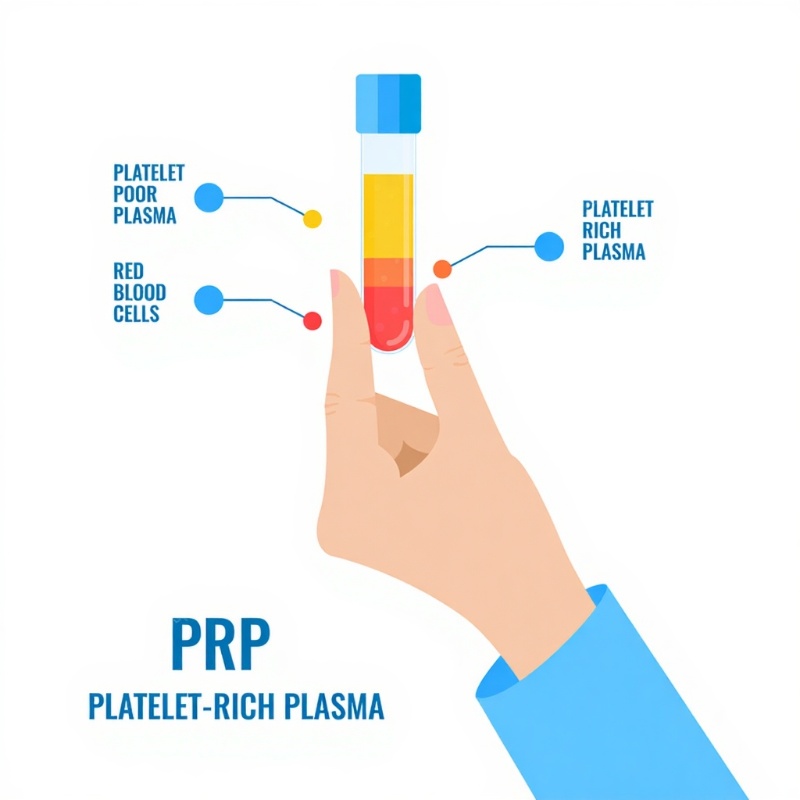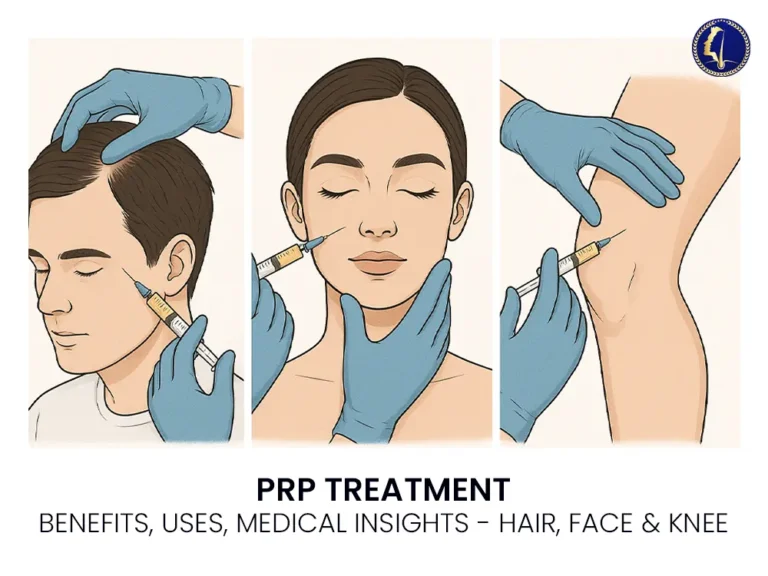Platelet-rich plasma PRP treatment has emerged as a revolutionary option in aesthetic medicine, dermatology, and regenerative therapy. Known for its natural healing properties, PRP hair therapy leverages your own blood components to stimulate collagen production, hair regrowth, and overall skin rejuvenation. Whether you are struggling with thinning hair, acne scars, or joint pain, understanding how PRP works and its benefits can help you make an informed decision.
What is Platelet-Rich Plasma Therapy or PRP Treatment?

PRP, or platelet-rich plasma treatment, is a non-surgical, minimally invasive procedure that uses the plasma component of your own blood, which is rich in platelets and growth factors. These growth factors play a crucial role in tissue repair, collagen stimulation, and cellular regeneration.
During the procedure, a small sample of your blood is drawn and processed in a centrifuge to separate the platelet-rich plasma from other components. This concentrated plasma is then injected into the target area—whether it’s the scalp, face, or joints—to stimulate healing and rejuvenation.
PRP therapy is considered safe because it uses autologous blood, meaning there is minimal risk of allergic reactions or infections.
How PRP Treatment Works
Platelet-rich plasma therapy or PRP treatment works through the body’s natural healing mechanisms. Platelets contain essential growth factors that activate stem cells and promote collagen synthesis. Here’s a step-by-step overview of the process:
Blood Collection: A small amount of blood is drawn from your arm.
Centrifugation: The blood is spun in a centrifuge to isolate platelet-rich plasma from red blood cells and plasma.
Activation: Platelets are activated to release growth factors.
Injection: The PRP is carefully injected into the targeted area—scalp, skin, or joint.
Healing Process: The growth factors stimulate tissue regeneration, collagen production, and improved cellular function.
This regenerative process is why PRP is used in various treatments, from hair regrowth therapy to anti-aging facial treatments and even joint pain relief in orthopedic medicine.
Benefits of PRP Treatment (Platelet-Rich Plasma Therapy)
PRP therapy has become highly sought after because of its versatility and natural approach. Here are some key benefits:
1. PRP Hair Loss Injection and Hair Regrowth
PRP injection for hair loss is one of the most popular applications. It helps stimulate dormant hair follicles, increase hair density, and improve hair thickness over multiple sessions. PRP is particularly effective for androgenic alopecia and thinning hair in both men and women.
2. Skin Rejuvenation
PRP treatment for face and skin rejuvenation, also known as a PRP facial, reduces fine lines, wrinkles, and acne scars. By stimulating collagen production and improving skin elasticity, patients experience smoother, firmer, and more youthful-looking skin.
3. Acne Scar Treatment
PRP injections promote healing in areas with acne scars by encouraging tissue regeneration. Combined with microneedling, PRP injection can significantly improve skin texture and reduce scar appearance.
4. Joint Pain Relief
PRP injection knee therapy is increasingly used in orthopedics to treat joint pain, tendon injuries, and osteoarthritis. The growth factors in PRP accelerate tissue repair and reduce inflammation, often helping patients regain mobility without invasive surgery.
5. Non-Surgical and Safe
Since PRP uses your own blood, it carries minimal risk of infection or allergic reactions. The procedure is minimally invasive, has little downtime, and is suitable for a wide range of patients.
Who is Suitable for PRP Treatment?
PRP treatment (Platelet-rich plasma) is suitable for individuals seeking natural solutions for hair loss, skin rejuvenation, or joint pain. Ideal candidates include:
Adults with thinning hair or androgenic alopecia
Individuals with fine lines, wrinkles, or acne scars
Patients with mild to moderate joint injuries or osteoarthritis
Those seeking minimally invasive, non-surgical cosmetic procedures
However, PRP injection may not be suitable for individuals with blood disorders, severe anemia, or certain chronic illnesses. Consulting with a certified dermatologist, trichologist, or orthopedic specialist is essential before starting treatment.
PRP Treatment Procedure and Recovery
The procedure typically takes 45–60 minutes per session. Most patients report minimal discomfort during the injection. Topical anesthesia may be applied for sensitive areas such as the scalp or face.
Recovery Tips:
Mild swelling or redness may occur for 1–2 days.
Avoid direct sun exposure immediately after treatment.
Follow your practitioner’s advice on skincare or hair care routines.
Multiple sessions (usually 3–6) are recommended for optimal results.
The results gradually appear over several weeks as collagen production and tissue regeneration progress.
PRP Treatment Cost in Malaysia
The cost of PRP treatment varies depending on the area treated and the number of sessions required. On average:
PRP for hair loss: RM 1,500 – RM 3,500 per session
PRP facial / skin rejuvenation: RM 1,200 – RM 2,800 per session
PRP for joints: RM 2,000 – RM 4,500 per joint
Prices may vary based on the clinic’s expertise, technology, and location. It’s essential to choose a reputable aesthetic or medical clinic with certified professionals.
PRP vs Other Treatments
PRP therapy is often compared with other regenerative or cosmetic treatments:
PRP vs Mesotherapy: PRP uses autologous blood and growth factors, while mesotherapy involves vitamins and synthetic compounds. PRP provides more natural regenerative effects.
PRP vs Hair Transplant In Malaysia: PRP stimulates existing hair growth, whereas hair transplant redistributes hair follicles. PRP is less invasive and complements hair transplant procedures.
PRP vs Chemical Peels / Lasers: PRP enhances natural tissue regeneration, whereas peels and lasers exfoliate or resurface the skin. PRP can be combined with these treatments for better results.
FAQs About PRP Treatment
1. How long does PRP treatment last?
PRP therapy results are gradual, typically visible after 3–6 sessions. Hair regrowth or skin rejuvenation benefits may last 12–18 months, depending on maintenance and lifestyle.
2. Is PRP treatment painful?
Most patients experience mild discomfort during injections. Topical anesthetics can minimize pain, making the procedure tolerable.
3. Are there any side effects of PRP therapy?
PRP is generally safe. Mild redness, swelling, or bruising may occur at the injection site but usually resolves within a few days.
4. Can PRP be combined with other treatments?
Yes. PRP is often combined with microneedling, laser therapy, or hair transplant procedures to enhance results.
5. How many PRP sessions are needed?
For optimal results, 3–6 sessions spaced 4–6 weeks apart are recommended. Follow-up treatments may be required for maintenance.
Conclusion
PRP treatment is a versatile and effective option for hair regrowth, skin rejuvenation, acne scar repair, and joint healing. Its natural, minimally invasive approach, combined with proven regenerative benefits, makes it an attractive choice for individuals seeking safe and long-lasting results.
Before undergoing PRP therapy, consult a certified aesthetic, dermatology, or orthopedic clinic to ensure suitability and receive a tailored treatment plan. With proper care and professional guidance, PRP can help you achieve healthier hair, youthful skin, and improved joint function naturally.
Restore Your Hair and Rejuvenate Your Skin with PRP Treatment

Experience the transformative power of PRP treatment at GLOJAS Plastic Surgery Specialist Clinic. Using your own platelet-rich plasma, our expert doctors stimulate hair regrowth and enhance skin rejuvenation safely and effectively. Reclaim your confidence with a natural, non-surgical solution tailored to your needs.
Book your consultation at GLOJAS Specialist Clinic Kuala Lumpur today and start your journey to healthier hair and radiant skin!
